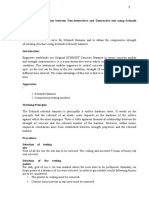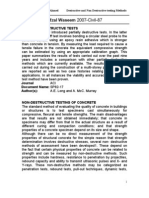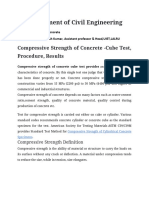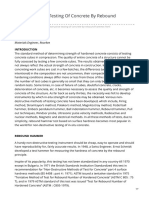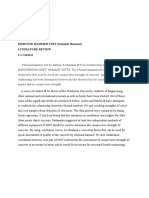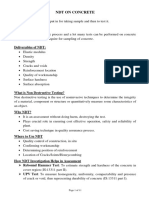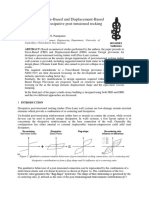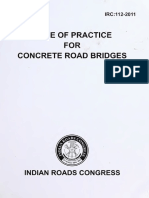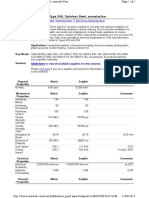Tests On Concrete (Viva Voce)
Tests On Concrete (Viva Voce)
Uploaded by
Mani KandanCopyright:
Available Formats
Tests On Concrete (Viva Voce)
Tests On Concrete (Viva Voce)
Uploaded by
Mani KandanOriginal Title
Copyright
Available Formats
Share this document
Did you find this document useful?
Is this content inappropriate?
Copyright:
Available Formats
Tests On Concrete (Viva Voce)
Tests On Concrete (Viva Voce)
Uploaded by
Mani KandanCopyright:
Available Formats
Tests on Concrete
1. Some concrete specification requires the testing of compressive strength for both 7 days and 28 days. Why? 7-day compressive strength test results are usually not used for acceptance purpose but for information only. Instead, 28-day compressive strength test results are commonly adopted for acceptance purpose. 7-day compressive strength test results are often used to monitor the gain of early strength and they are estimated to be about 64% to 70% of the 28-day strength. As such, it serves as a warning signal to both concrete producers and contractors should the 7-day compressive strength test results are far less than 75% of the 28-day strength. Nowadays, most concrete placement schedule are very tight and it is of paramount importance for contractors to get to know as soon as possible the occurrence of low 7-day compressive strength test results. As such, the contractor could implement suitable measures promptly to get better quality control procedures at construction site and to monitor closely on sampling, molding, and testing of the test cubes so as to avoid the recurrence of the production of low-strength concrete in the coming concrete batches. 2. Is Schmidt hammer test a standard test for testing concrete strength? The Schmidt hammer test involves hitting the in-situ concrete with a spring-driven pin at a defined energy, and then the rebound is measured. The rebound depends on the surface hardness of the concrete and is measured by test equipment. By referring to the some conversion tables, the rebound result of the test can be used to determine the compressive strength of the concrete. Although past investigations showed that there is a general relationship between compressive strength of concrete and the rebound number, there is a wide range of disagreement among various research workers regarding the accuracy of estimation of strength from Schmidt hammer. In fact, there is about a variation of 15-20% in concrete strength measured by the method. Schmidt hammer is in not a standard test for acceptance testing of concrete strength. It is only a test used for estimating the strength of concrete in structure and it can hardly be considered as a substitute for compressive strength test. 3. In concrete compression test, normally 150mmx150mmx150mm concrete cube samples is used for testing. Why isnt 100mmx100mmx100mm concrete cube samples used in the test instead of 150mmx150mmx150mm concrete cube samples? Basically, the force supplied by a concrete compression machine is a definite value. For normal concrete strength application, say below 50MPa, the stress produced by a 150mmx150mmx150mm cube is sufficient for the machine to crush the concrete sample. However, if the designed concrete strength is
100MPa, under the same force (about 2,000kN) supplied by the machine, the stress under a 150mmx150mmx150mm cube is not sufficient to crush the concrete cube. Therefore, 100mmx100mmx100mm concrete cubes are used instead to increase the applied stress to crush the concrete cubes. For normal concrete strength, the cube size of 150mmx150mmx150mm is already sufficient for the crushing strength of the machine. 4. If concrete compression test fails, should Schmidt hammer test be adopted as an alternative test to prove the concrete strength? The Schmidt hammer test is based on the elastic rebound of hammer which presses on concrete surface and it measure the surface hardness of concrete. Since the test is very sensitive to the presence of aggregates and voids at the concrete surface, it is necessary to take more than 10 readings over the area of test. However, it should be noted that Schmidt hammer test measures surface hardness only but not the strength of concrete. Therefore, it may not be considered a good substitute for concrete compression test. 5. In carrying out compression test for concrete, should test cubes or test cylinders be adopted? Basically, the results of compression test carried out by using cubes are higher than that by cylinders. In compression test, the failure mode is in the form of tensile splitting induced by uniaxial compression. However, since the concrete samples tend to expand laterally under compression, the friction developed at the concrete-machine interface generates forces which apparently increase the compressive strength of concrete. However, when the ratio of height to width of sample increases, the effect of shear on compressive strength becomes smaller. This explains why the results of compression test by cylinders are lower than that of cubes. Reference is made to Longman Scientific and Technical (1987). 6. Explain why the tensile strength of concrete is much less than the compressive strength. What is the range of tensile strength of concrete? In concrete there exists numerous fine cracks which lower the tensile strength. When a compressive load is applied, the compressive stress can push up any crack in concrete and can be transferred through the cracks. On the other hand, when a tensile load is applied, tensile stress pulls up the concrete and can be transferred only through the uncracked concrete. The average tensile stress may be small; the actual stress in uncracked concrete is much larger. This further causes the cracks to lengthen which reduces the uncracked concrete area. Thus the tensile strength of concrete is much lower than the compressive strength. Tensile strength of concrete ranges from 10% to 18% of its compressive strength.
7. What is modulus of rupture of concrete? How is it measured? The normal tensile stress in concrete when cracking occurs in a flexure test is known as modulus of rupture of concrete. If it is measured by performing a flexure test on unreinforced concrete beam of specified size and span considering concrete to be homogeneous. In absence of the test, the flexural strength of concrete may be taken as 8. Why does cube specimen indicate more strength in comparison to cylindrical specimen? Explain. In case of cube the interface shear developed between machine platen and the specimen influences the whole specimen and almost the whole specimen is covered under restraining effect. In case of cylinder the central portion is unprotected and failure starts in this portion much earlier. Non destructive testing allows repeated testing and testing on actual structure. But as the specimen in this case is not taken to destruction the strength parameter can not be directly measured from this method. Hence some other Physical/Mechanical parameter is measured and then this parameter is linked with strength parameter. So this is an indirect way of measurent of strength. However this testing makes possible a study of the variation in properties with time. As this is indirect way of measurement of strength, it requires more judgement, experience and skill.
9. How would you determine tensile strength? Write factors affecting tensile strength. Flexure tensile strength is higher than direct tensile strength because
Why packing material is interposed between machine plate and cylinder while carrying out split test? Due to some inherent difficulties the tensile strength of the concrete cannot be measured directly. Firstly, it is very difficult to innovate a gripping device which will not introduce secondary stresses along with local stress concentration. Secondly, it is impossible to avoid eccentricity of loading due to non coincidence of specimen axis and load axis which will alter the stress pattern in the specimen. The third problem encountered is that the specimen generally fails near the end. This problem is generally overcome by reducing the cross-sectional area of the central portion of the test specimen. However, some attempts have been made in which steel plates are glued with epoxies to the ends of test specimen to facilitate direct pulling but without much success. Also all direct tension test methods require expensive Universal Testing Machine. Due to all these reasons tensile strength is generally not determined by applying direct tension. Loading rate in case of i) Cube test is 14 N/mm2/min ii) Beam test is 4 kN/min for beam size of 150 x 150 x 750 mm and 1.8 kN/min for 100 x 100 x 500 mm specimens. iii) Cylinder test is 1.2 N/mm2/min to 2.4 N/mm2/min What are the basic differences between Destructive Testing and Nondestructive testing? Under what circumstances each of them is used? In destructive testing the samples are taken separately from the manufactured concrete placed, cast, cured and tested separately simulating as far as possible the site conditions in the laboratory. The specimen even may not be tested as cast position though the structure will primarily loaded as cast position. Except that specimen as also the structure is made from an concrete, their placement, casting, compacting, curing and loading conditions are different, However as the specimen is taken to destruction, the destructive testing gives intrinsic strength of concrete. -----------------------------------The tensile strength of concrete is generally ignored in the ultimate limit state design, but is used in the serviceability limit state to determine cracking criteria, which in turn influences deflections. It is used in the design of liquid-containing structures where cracking is a major consideration. The tensile strength relates to the maximum stress which concrete can withstand when subjected to uniaxial tension. The tensile strength does not bear a constant relation to the compressive strength, but is approximately 10% of the compressive strength.
You might also like
- Aluminum Alloy Castings PropertiesDocument321 pagesAluminum Alloy Castings Propertieswawawa188% (8)
- Calculations: Beam Design-Ultimate Strength Design: (Aci 318)Document10 pagesCalculations: Beam Design-Ultimate Strength Design: (Aci 318)Anass SoubraNo ratings yet
- Concrete TestingDocument32 pagesConcrete TestingAveesh singh100% (2)
- Specification ASTM D3350 PDFDocument110 pagesSpecification ASTM D3350 PDFraja reyhan100% (1)
- Part1 Damage Tolerance OverviewDocument63 pagesPart1 Damage Tolerance Overviewmatmarcantonio100% (8)
- Size Effects in Concrete TestingDocument5 pagesSize Effects in Concrete TestingSyed Muhammad TaqiNo ratings yet
- EN21481376Document9 pagesEN21481376Yoshua DylanNo ratings yet
- Factors Affecting StrengthDocument5 pagesFactors Affecting StrengthIsbelNo ratings yet
- Smidt HammerDocument9 pagesSmidt HammerSANDESHNo ratings yet
- Nondestructive Testing and Evaluation in Structural AnalysisDocument14 pagesNondestructive Testing and Evaluation in Structural AnalysisChalakAhmedNo ratings yet
- Rebound Number of Hardened ConcreteDocument5 pagesRebound Number of Hardened ConcreteTabish IslamNo ratings yet
- Compressive Strength of ConcreteDocument9 pagesCompressive Strength of ConcreteAmos kipruto100% (1)
- Non Destructive Test On ConcreteDocument6 pagesNon Destructive Test On ConcreteOpany JuliusNo ratings yet
- Rebound Hammer ReportDocument17 pagesRebound Hammer ReportSYaz WAni25% (4)
- Concrete Testing-11Document32 pagesConcrete Testing-11kamal hameed tayy75% (8)
- Non-Destructive Testing of ConcreteDocument10 pagesNon-Destructive Testing of Concretetwinkle starNo ratings yet
- Concrete Fail in Compressive Strength Cube 368Document11 pagesConcrete Fail in Compressive Strength Cube 368talatzahoor100% (1)
- Testing The Compressive Strength of Concrete - What, Why, & How - Nevada Ready MixDocument2 pagesTesting The Compressive Strength of Concrete - What, Why, & How - Nevada Ready MixPritha DasNo ratings yet
- Rebound HammerDocument6 pagesRebound HammerDira AzmanNo ratings yet
- What Is Stamped ConcreteDocument6 pagesWhat Is Stamped ConcreteNick GeneseNo ratings yet
- PARTIALLY DESTRUCTIVE TESTS and NON DESTRUCTIVE TESTINGDocument4 pagesPARTIALLY DESTRUCTIVE TESTS and NON DESTRUCTIVE TESTINGAfzal Waseem100% (1)
- Conducting A Compressive Strength TestDocument8 pagesConducting A Compressive Strength TestCeleste Amor Factor100% (1)
- Flexural Test On Concrete Based On The ASTM Standards Are ExplainedDocument9 pagesFlexural Test On Concrete Based On The ASTM Standards Are ExplainedTesfayeNo ratings yet
- CT Unit II, part BDocument27 pagesCT Unit II, part Brahulnagwe003No ratings yet
- Literatur Review On Rebound HammerDocument4 pagesLiteratur Review On Rebound HammerAnshul JainNo ratings yet
- Unit-2 NDT NotesDocument7 pagesUnit-2 NDT NotesMeena Channe GowdaNo ratings yet
- Strength of Concrete 1Document12 pagesStrength of Concrete 1maneeshaNo ratings yet
- Core Strength Variation of In-Place Concrete - tcm77-1305833Document3 pagesCore Strength Variation of In-Place Concrete - tcm77-1305833usama anterNo ratings yet
- Methods of Non-Destructive Testing of Concrete: 1. Penetration Tests On ConcreteDocument6 pagesMethods of Non-Destructive Testing of Concrete: 1. Penetration Tests On ConcreteAbuzar AliNo ratings yet
- Compression Testing of Concrete Cylinders vs. CubesDocument13 pagesCompression Testing of Concrete Cylinders vs. CubesJAZPAKNo ratings yet
- Hardened ConcreteDocument50 pagesHardened ConcreteMayank KapriNo ratings yet
- Finding Compressive Strength Using Schmidt Hammer TestDocument13 pagesFinding Compressive Strength Using Schmidt Hammer TestChalakAhmedNo ratings yet
- Strength Test On ConcreteDocument23 pagesStrength Test On ConcreteMukesh Kumar SamotaNo ratings yet
- Compressive Strength of Concrete & Concrete Cubes - What - How - CivilDigitalDocument13 pagesCompressive Strength of Concrete & Concrete Cubes - What - How - CivilDigitalArdhi TaNo ratings yet
- Compression Test of Concrete CubeDocument10 pagesCompression Test of Concrete CubeRose Shazilah100% (2)
- Tests and Acceptance Criteria For Concrete Based On Compressive Strength by Diwan Singh Bora IDSEDocument9 pagesTests and Acceptance Criteria For Concrete Based On Compressive Strength by Diwan Singh Bora IDSEArindam NandyNo ratings yet
- Split Tensile Strength of ConcreteDocument9 pagesSplit Tensile Strength of Concreteabhineet srivastavaNo ratings yet
- Comparison of Core and Cube Compressive Strength of Hardened Concrete 02 JuneDocument6 pagesComparison of Core and Cube Compressive Strength of Hardened Concrete 02 JuneGJESRNo ratings yet
- Rebound Hammer PDFDocument6 pagesRebound Hammer PDFAnonymous AJy7S7flB100% (2)
- Advanced Concrete TechnologyDocument10 pagesAdvanced Concrete TechnologyismailNo ratings yet
- Non-Destructive Test of Concrete and Masonry: Khwopa Engineering CollegeDocument11 pagesNon-Destructive Test of Concrete and Masonry: Khwopa Engineering CollegeJeewanNo ratings yet
- Bldg. Sanitation, Code & RulesDocument8 pagesBldg. Sanitation, Code & RulesNick GeneseNo ratings yet
- Libro de Reforzamiento HORMIGON ARMADO 2022-4Document25 pagesLibro de Reforzamiento HORMIGON ARMADO 2022-4David Magne MamaniNo ratings yet
- Lecture 2 - MaterialsDocument59 pagesLecture 2 - Materialsirfan aliNo ratings yet
- Testing of Concrete and Quality ControlDocument8 pagesTesting of Concrete and Quality ControlShuvanjan Dahal100% (2)
- CV1013 - Concrete - 9 Testing of Hardened Concrete - S2 19-20Document29 pagesCV1013 - Concrete - 9 Testing of Hardened Concrete - S2 19-20Ash KongNo ratings yet
- Determination of Tensile Strength of Concrete Cylinder (Split Tension or Equivalent)Document4 pagesDetermination of Tensile Strength of Concrete Cylinder (Split Tension or Equivalent)Ceddie PamintuanNo ratings yet
- Cube TestDocument11 pagesCube TestKe Sing100% (2)
- Rebound Hammer Test On ConcreteDocument10 pagesRebound Hammer Test On ConcreteSunil KumarNo ratings yet
- Pull Out TestDocument4 pagesPull Out TestAjoy Mc100% (1)
- Non-Destructive Testing of Concrete by Rebound HammerDocument6 pagesNon-Destructive Testing of Concrete by Rebound HammerPoirei ZildjianNo ratings yet
- Hardened Concrete1Document16 pagesHardened Concrete1victor mutaiNo ratings yet
- 02 Experimental Stress AnalysisDocument17 pages02 Experimental Stress AnalysisayadNo ratings yet
- Non-Destructive Testing of Concrete by Rebound HammerDocument7 pagesNon-Destructive Testing of Concrete by Rebound HammerPradeep PokhrelNo ratings yet
- Literature Review and ConclusionDocument12 pagesLiterature Review and ConclusionHaiqal RafiqNo ratings yet
- Factors That Influence The Tensile StrengthDocument47 pagesFactors That Influence The Tensile StrengthOvidiu GalNo ratings yet
- NDT On Concrete: Destructive TestingDocument11 pagesNDT On Concrete: Destructive TestingMITHLESH KUMAR KESHARINo ratings yet
- Schmidt Rebound Hammer TestDocument3 pagesSchmidt Rebound Hammer Testh4m0n4ng4n100% (1)
- Flexural Strength of ConcreteDocument2 pagesFlexural Strength of ConcreteVenkataLakshmiKorrapatiNo ratings yet
- Hardened ConcreteDocument40 pagesHardened ConcreteHVRANANo ratings yet
- COTM 6031 Harden Concrete TestsDocument21 pagesCOTM 6031 Harden Concrete TestsChina AlemayehouNo ratings yet
- For My Students:: Always Treat Your Parents With Utmost Respect and KindnessDocument36 pagesFor My Students:: Always Treat Your Parents With Utmost Respect and KindnessHefon MarketerNo ratings yet
- M. Tech SynopsisDocument8 pagesM. Tech SynopsisemtiazNo ratings yet
- 4 Hours / 100 MarksDocument26 pages4 Hours / 100 MarksPandit BarelaNo ratings yet
- Material PropertiesDocument2 pagesMaterial PropertiesCelineKevinNo ratings yet
- Calculations Mechanical Design F1Document13 pagesCalculations Mechanical Design F1Izreen FaraNo ratings yet
- Analysis of The Behaviour of Stainless Steel Bolted ConnectionsDocument11 pagesAnalysis of The Behaviour of Stainless Steel Bolted ConnectionsSam SamouraNo ratings yet
- RC Beam - Singly - NSCP 2015 by RgceDocument4 pagesRC Beam - Singly - NSCP 2015 by RgceJet ToledoNo ratings yet
- 6 Hull DamagesDocument37 pages6 Hull DamagesG.O.D 7No ratings yet
- GBT 1591-2008Document17 pagesGBT 1591-2008Manuel Rodrigo Cortés Vásquez100% (2)
- Section 10 ConnectionsDocument17 pagesSection 10 ConnectionsThirupathi RajaNo ratings yet
- Chapter 2-Strain EditedDocument44 pagesChapter 2-Strain EditedRuel Japhet BitoyNo ratings yet
- Mathematical Modelling of The Mechanics of Core Drilling in GeomaterialsDocument25 pagesMathematical Modelling of The Mechanics of Core Drilling in Geomaterialscvlpla55No ratings yet
- 19Mnvs6: Steel GradeDocument3 pages19Mnvs6: Steel GradeForin PetalNo ratings yet
- Advanced Continuous Annealing Technology and Application For High-Strength SteelDocument10 pagesAdvanced Continuous Annealing Technology and Application For High-Strength SteelJJNo ratings yet
- 2015NZSEE-SARTI ET AL Comparison of Force-Based and Displacement-Based Seismic Design of Dissipative Post-Tensioned Rocking Timber Wall SystemsDocument10 pages2015NZSEE-SARTI ET AL Comparison of Force-Based and Displacement-Based Seismic Design of Dissipative Post-Tensioned Rocking Timber Wall SystemsFrancesco SartiNo ratings yet
- Steel Sheet, Metallic-Coated by The Hot-Dip Process For Corrugated Steel PipeDocument4 pagesSteel Sheet, Metallic-Coated by The Hot-Dip Process For Corrugated Steel PipeWilliam AguilarNo ratings yet
- Iso 8686 1 2012Document15 pagesIso 8686 1 2012Partha Pratim SarkarNo ratings yet
- TPU Technical DatasheetDocument2 pagesTPU Technical Datasheetromi supriyonoNo ratings yet
- Shear Wall Design ReportDocument26 pagesShear Wall Design ReportAli ImranNo ratings yet
- HACON - A Program For Temperature and Stress SimulationDocument68 pagesHACON - A Program For Temperature and Stress SimulationvalentinlucNo ratings yet
- Irc 2011 112Document296 pagesIrc 2011 112ErSoravNo ratings yet
- Chapter 6 Fatigue Failure TheoriesDocument32 pagesChapter 6 Fatigue Failure Theorieslth770310No ratings yet
- Design Calculations Book For Pms Shed H-Building: 119'6" X 219'9" X 12' Client: Pakistan NavyDocument95 pagesDesign Calculations Book For Pms Shed H-Building: 119'6" X 219'9" X 12' Client: Pakistan NavyBilal CHNo ratings yet
- 316L-SS-annealed BarDocument2 pages316L-SS-annealed BarARUNKANNANNo ratings yet
- Friction Stir Processing of Aluminum AlloysDocument93 pagesFriction Stir Processing of Aluminum AlloyssatyajitNo ratings yet
- Analysis and Design of Ferrocement Panels An Experimental StudyDocument8 pagesAnalysis and Design of Ferrocement Panels An Experimental StudyNick CordetaNo ratings yet
- Davit Design and Support CalculationDocument22 pagesDavit Design and Support CalculationShan50% (2)
- Titanium As A Biomaterial For ImplantsDocument16 pagesTitanium As A Biomaterial For Implantsanilsamuel0077418No ratings yet








